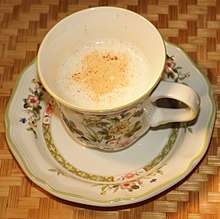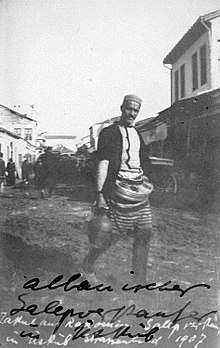Salep
Salep, also spelled sahlep or sahlab,[note 1] is a flour made from the tubers of the orchid genus Orchis (including species Orchis mascula and Orchis militaris). These tubers contain a nutritious, starchy polysaccharide called glucomannan. Salep flour is consumed in beverages and desserts, especially in the cuisines of the former Ottoman Empire, notably in the Levant where it is a traditional winter beverage. An increase in consumption is causing local extinctions of orchids in parts of Turkey and Iran.[1]

Etymology
The word "salep" comes from Arabic: سَحْلَب (saḥlab).[2] In the mid 18th century: from French, from Turkish sālep, from Arabic: ثَعْلَب, romanized: ﭐلثَعْلَب, lit. 'fox's' (aṯ-ṯaʿlabi), the name of an orchid (literally ‘fox's testicles’).[3][4][5]
History

The Ancient Romans used ground orchid bulbs to make drinks, which they called by a number of names, especially satyrion and priapiscus. As the names indicate, they likewise considered it to be a powerful aphrodisiac.[6] Of salep, Paracelsus wrote: "behold the Satyrion root, is it not formed like the male privy parts? No one can deny this. Accordingly, magic discovered it and revealed that it can restore a man's virility and passion".[7]
Salep was a popular beverage in the lands of the Ottoman Empire. Its consumption spread beyond there to England and Germany before the rise of coffee and tea and it was later offered as an alternative beverage in coffee houses. In England, the drink was known as saloop. Popular in the 17th and 18th centuries in England, its preparation required that the salep powder be added to water until thickened whereupon it would be sweetened, then flavored with orange flower or rose water. Substitution of British orchid roots, known as "dogstones", was acceptable in the 18th century for the original Turkish variants.[8]
Saloop
_-_BL.jpg)
Saloop was a hot drink that was popular in England in the 18th and 19th centuries. Initially, it was made from salep, mostly from Smyrna.[10] Later, the roots and leaves of the North American sassafras tree were the key ingredient. This plant thickened the drink and also had a stimulating quality.[11][12]
This refreshing beverage was sold in place of tea and coffee, which were much more expensive, and was served in a similar way with milk and sugar.
It was used as a remedy for various ailments, including "chronic alcoholic inebriety."[13] Its popularity declined when it was purported to treat venereal disease and so drinking it in public became shameful.[14] Saloop stalls in London were replaced by coffee stalls.[15]
Modern use
The beverage sahlab is now often made with hot milk instead of water. Other desserts are also made from salep flour, including salep pudding and dondurma. The Kahramanmaraş region of Turkey is a major producer of sahlab known as Salepi Maraş. The popularity of sahlab in Turkey has led to a decline in the populations of wild orchids. As a result, it is illegal to export true salep.[16] Thus, many instant sahlab mixes are made with artificial flavoring. Salep is also consumed in Greece, and it is usually sold on the streets as a hot beverage during the cold months of the year. It is very popular in many parts of the Middle East, especially the Levant. Families in Turkey drink the hot version during the winter time.
It is estimated that, each year in Turkey, 30 tons of tubers from 38 species are harvested, and it takes from 1,000 to 4,000 tubers to make a kilo of flour.[17] With the increasing rarity of some species and local extinctions, traders are harvesting wild orchids in Iran. Abdolbaset Ghorbani of Uppsala University estimates that between 7 and 11 million orchids of nineteen species and sub-species were collected from northern Iran in 2013; with the majority being exported to Turkey.[1] Harvesting of orchid tubers is also increasing in Greece.[1]
In the Middle East, "sahlab" is a hot milk-based winter drink with a pudding-like consistency, sometimes garnished with nuts and cinnamon.[18]
Footnotes
- (Turkish: salep, sahlep; Persian: ثعلب, sa'alab; Arabic: سحلب, saḥlab; Albanian: salep; Azerbaijani: səhləb; Hebrew: סַחְלָבּ, saḥlab; Greek: σαλέπι, salepi; Serbian, Macedonian, Bulgarian and Bosnian: салеп, salep)
References
- Pain, Stephanie (6 May 2017). "Eaten to extinction". New Scientist. No. 3124. pp. 32–4.
- "salep." Online Etymology Dictionary. 2008.
- "salep - definition of salep in English | Oxford Dictionaries". Oxford Dictionaries | English.
- "Definition of SALEP". www.merriam-webster.com.
- "the definition of salep". Dictionary.com.
- Dalby, p. 292; Theophrastus, 9.18.13; Pedanius Dioscorides, 3.126-8; Pliny the Elder, 26.95-98, 27.65; Pseudo-Apuleius, 15.3.
- Jacobi, ed., p. 122.
- Davidson, p. 683.
- Thomas Rowlandson (1820), Rowlandson's Characteristic Sketches of the Lower Orders of the British Metropolis, Samuel Leigh
- Church, A.H. (1893). Food: some account of its sources, constituents and uses. The University of Leeds Library: Chapman and Hall Ld. p. 29.
- Holly Chase (1994), "Suspect Salep", Look and Feel: Studies In Texture, Appearance and Incidental Characteristics of Food, Oxford Symposium, pp. 45–46, ISBN 978-0907325567
- Edwin Augustus Peeples (1994), Planting an Inheritance, Stackpole Books, p. 62, ISBN 978-0811712064
- Ward, Artemas. The encyclopedia of food: their comparative values and how best to use and enjoy them. 1923. p. 451.
- Jonathan Pereira (2014), The Elements of Materia Medica and Therapeutics, 1, Cambridge University Press, p. 463, ISBN 978-1108068833
- Mayhew, Henry (1861). London Labour and the London Poor. 1. p. 27.
- "Ice cream threatens Turkey's flowers". BBC News. 5 August 2003. Retrieved 9 November 2015.
- Eng Soon Teoh Orchids as Aphrodisiac, Medicine or Food (2019), p. 52, at Google Books
- "Sachlav: The Hot Chocolate of the Middle East". The Forward. Retrieved 30 October 2019.
Cited texts
- Dalby, Andrew (2003). Food in the Ancient World: from A to Z. Routledge. ISBN 978-0-415-23259-3.
- Davidson, Alan (1987). Oxford Companion to Food. Oxford University Press. ISBN 978-0-19-211579-9.
- "Ice cream threatens Turkey's flowers". BBC News. August 5, 2003.
- Jacobi, Jolande, ed. (1995). Paracelsus: Selected Writings. Princeton University Press. ISBN 978-0-691-01876-8.
- Pedanius Dioscorides. De materia medica.
- Pliny the Elder. Naturalis historia.
- Pseudo-Apuleius. Herbarium Apuleii Platonici.
- Theophrastus. Historia plantarum.
External links
| Look up Saloop in Wiktionary, the free dictionary. |
